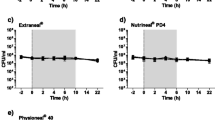Abstract
Peritoneal dialysis used in the treatment of patients with end-stage renal failure is often complicated by peritonitis. Staphylococcus aureus peritonitis is severe, particularly if caused by a methicillin-resistant strain (MRSA). Intraperitoneal administration of drugs for treatment of peritonitis is preferable to intravenous or oral routes because of the resulting higher local antibiotic concentrations. However, peritoneal dialysis fluids (PDFs) have a bacteriostatic effect, which may compromise the efficacy of antibiotics. The bactericidal efficacy of vancomycin, teicoplanin, daptomycin and ceftobiprole was studied in the PDFs Dianeal PD4® (glucose 1.36%), Physioneal 40® (glucose 1.36%), Extraneal® (7.5% icodextrin), and Nutrineal PD4® (1.1% amino acid) using time-kill curves. To simulate in vivo conditions, human serum albumin was added at a final concentration of 2 g/l. All four PDFs had a bacteriostatic effect on the growth of the MRSA test isolate. All antibiotics showed less activity in PDFs compared to control broth. Vancomycin and teicoplanin achieved the greatest reduction in bacterial numbers in the amino-acid containing PDF Nutrineal PD4®. Daptomycin showed its highest activity in Extraneal® and better overall efficacy than the other tested antibiotics. Ceftobiprole showed no killing activities in any of the four PDFs. Based on these in vitro data we conclude that the choice of PDFs for intraperitoneal administration is not trivial and could be crucial for therapy outcome.




Similar content being viewed by others
References
Piraino B, Bailie GR, Bernardini J, Boeschoten E, Gupta A, Holmes C, Kuijper EJ, Li PK, Lye WC, Mujais S, Paterson DL, Fontan MP, Ramos A, Schaefer F, Uttley L (2005) Peritoneal dialysis-related infections recommendations: 2005 update. Perit Dial Int 25(2):107–131
Perez Fontan M, Rodriguez-Carmona A, Garcia-Naveiro R, Rosales M, Villaverde P, Valdes F (2005) Peritonitis-related mortality in patients undergoing chronic peritoneal dialysis. Perit Dial Int 25(3):274–284
Fried L, Abidi S, Bernardini J, Johnston JR, Piraino B (1999) Hospitalization in peritoneal dialysis patients. Am J Kidney Dis 33(5):927–933
Fried LF, Bernardini J, Johnston JR, Piraino B (1996) Peritonitis influences mortality in peritoneal dialysis patients. J Am Soc Nephrol 7(10):2176–2182
Finkelstein ES, Jekel J, Troidle L, Gorban-Brennan N, Finkelstein FO, Bia FJ (2002) Patterns of infection in patients maintained on long-term peritoneal dialysis therapy with multiple episodes of peritonitis. Am J Kidney Dis 39(6):1278–1286
Li PK, Szeto CC, Piraino B, Bernardini J, Figueiredo AE, Gupta A, Johnson DW, Kuijper EJ, Lye WC, Salzer W, Schaefer F, Struijk DG (2010) Peritoneal dialysis-related infections recommendations: 2010 update. Perit Dial Int 30(4):393–423
Cozens RM, Tuomanen E, Tosch W, Zak O, Suter J, Tomasz A (1986) Evaluation of the bactericidal activity of beta-lactam antibiotics on slowly growing bacteria cultured in the chemostat. Antimicrob Agents Chemother 29(5):797–802
Tuomanen E, Cozens R, Tosch W, Zak O, Tomasz A (1986) The rate of killing of Escherichia coli by beta-lactam antibiotics is strictly proportional to the rate of bacterial growth. J Gen Microbiol 132(5):1297–1304
Clouse FL, Hovde LB, Rotschafer JC (2007) In vitro evaluation of the activities of telavancin, cefazolin, and vancomycin against methicillin-susceptible and methicillin-resistant Staphylococcus aureus in peritoneal dialysate. Antimicrob Agents Chemother 51(12):4521–4524
Hermsen ED, Hovde LB, Hotchkiss JR, Rotschafer JC (2003) Increased killing of staphylococci and streptococci by daptomycin compared with cefazolin and vancomycin in an in vitro peritoneal dialysate model. Antimicrob Agents Chemother 47(12):3764–3767
Clinical Laboratory Standards Institute C (2008) Performance standards for antimicrobial susceptibility testing; 18th informational supplement M100-S18. Wayne, PA, USA
Zelenitsky S, Barns L, Findlay I, Alfa M, Ariano R, Fine A, Harding G (2000) Analysis of microbiological trends in peritoneal dialysis-related peritonitis from 1991 to 1998. Am J Kidney Dis 36(5):1009–1013
Xu G, Tu W, Xu C (2010) Mupirocin for preventing exit-site infection and peritonitis in patients undergoing peritoneal dialysis. Nephrol Dial Transplant 25(2):587–592
de Vin F, Rutherford P, Faict D (2009) Intraperitoneal administration of drugs in peritoneal dialysis patients: a review of compatibility and guidance for clinical use. Perit Dial Int 29(1):5–15
McDonald WA, Watts J, Bowmer MI (1986) Factors affecting Staphylococcus epidermidis growth in peritoneal dialysis solutions. J Clin Microbiol 24(1):104–107
Schwartz MA, Buckwalter FH (1962) Pharmaceutics of penicillin. J Pharm Sci 51:1119–1128
Mascio CT, Alder JD, Silverman JA (2007) Bactericidal action of daptomycin against stationary-phase and nondividing Staphylococcus aureus cells. Antimicrob Agents Chemother 51(12):4255–4260
Carpenter CF, Chambers HF (2004) Daptomycin: another novel agent for treating infections due to drug-resistant gram-positive pathogens. Clin Infect Dis 38(7):994–1000
Salzer W (2005) Antimicrobial-resistant gram-positive bacteria in PD peritonitis and the newer antibiotics used to treat them. Perit Dial Int 25(4):313–319
Wiggins KJ, Johnson DW, Craig JC, Strippoli GF (2007) Treatment of peritoneal dialysis-associated peritonitis: a systematic review of randomized controlled trials. Am J Kidney Dis 50(6):967–988
Funding
This work was supported by internal funding.
Transparency declarations
None to declare.
Author information
Authors and Affiliations
Corresponding author
Rights and permissions
About this article
Cite this article
Tobudic, S., Poeppl, W., Kratzer, C. et al. Comparative in vitro antimicrobial activity of vancomycin, teicoplanin, daptomycin and ceftobiprole in four different peritoneal dialysis fluids. Eur J Clin Microbiol Infect Dis 31, 1327–1334 (2012). https://doi.org/10.1007/s10096-011-1446-0
Received:
Accepted:
Published:
Issue Date:
DOI: https://doi.org/10.1007/s10096-011-1446-0




